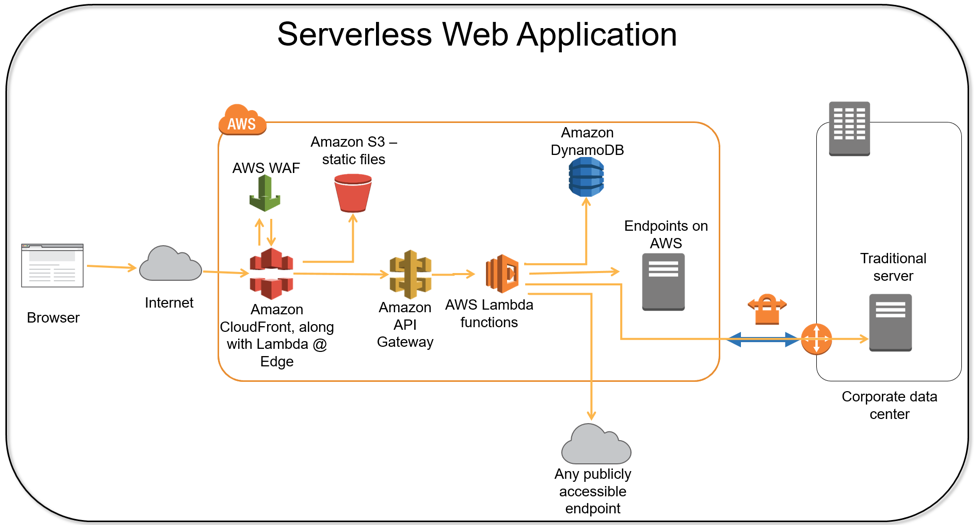AWS Compute Blog
Category: AWS Step Functions
From Poll to Push: Transform APIs using Amazon API Gateway REST APIs and WebSockets
This post is courtesy of Adam Westrich – AWS Principal Solutions Architect and Ronan Prenty – Cloud Support Engineer Want to deploy a web application and give a large number of users controlled access to data analytics? Or maybe you have a retail site that is fulfilling purchase orders, or an app that enables users to […]
ICYMI: Serverless Q4 2018
This post is courtesy of Eric Johnson, Senior Developer Advocate – AWS Serverless Welcome to the fourth edition of the AWS Serverless ICYMI (in case you missed it) quarterly recap. Every quarter, we share all of the most recent product launches, feature enhancements, blog posts, webinars, Twitch live streams, and other interesting things that you […]
Building Simpler Genomics Workflows on AWS Step Functions
This post is courtesy of Ryan Ulaszek, AWS Genomics Partner Solutions Architect and Aaron Friedman, AWS Healthcare and Life Sciences Partner Solutions Architect In 2017, we published a four part blog series on how to build a genomics workflow on AWS. In part 1, we introduced a general architecture highlighting three common layers: job, batch and […]
ICYMI: Serverless Q3 2018
Welcome to the third edition of the AWS Serverless ICYMI (in case you missed it) quarterly recap. Every quarter, we share all of the most recent product launches, feature enhancements, blog posts, webinars, Twitch live streams, and other interesting things that you might have missed! If you didn’t see them, catch our Q1 ICYMI and […]
Implementing Serverless Video Subtitles
This post is courtesy of Maxime Thomas, DevOps Partner Solutions Architect – AWS This story begins when I joined AWS at the beginning of the year. I had a hard time during my ramp-up period trying to handle the amount of information coming from all directions. Technical training, meetings, new colleagues, in a worldwide company—the […]
ICYMI: Serverless Q2 2018
The better-late-than-never edition! Welcome to the second edition of the AWS Serverless ICYMI (in case you missed it) quarterly recap. Every quarter, we share all of the most recent product launches, feature enhancements, blog posts, webinars, Twitch live streams, and other interesting things that you might have missed! The second quarter of 2018 flew by […]
Powering HIPAA-compliant workloads using AWS Serverless technologies
This post courtesy of Mayank Thakkar, AWS Senior Solutions Architect Serverless computing refers to an architecture discipline that allows you to build and run applications or services without thinking about servers. You can focus on your applications, without worrying about provisioning, scaling, or managing any servers. You can use serverless architectures for nearly any type […]
Implementing Dynamic ETL Pipelines Using AWS Step Functions
This post contributed by: Wangechi Dole, AWS Solutions Architect Milan Krasnansky, ING, Digital Solutions Developer, SGK Rian Mookencherry, Director – Product Innovation, SGK Data processing and transformation is a common use case you see in our customer case studies and success stories. Often, customers deal with complex data from a variety of sources that needs […]
Implementing Canary Deployments of AWS Lambda Functions with Alias Traffic Shifting
This post courtesy of Ryan Green, Software Development Engineer, AWS Serverless The concepts of blue/green and canary deployments have been around for a while now and have been well-established as best-practices for reducing the risk of software deployments. In a traditional, horizontally scaled application, copies of the application code are deployed to multiple nodes (instances, […]
Serverless Automated Cost Controls, Part1
This post courtesy of Shankar Ramachandran, Pubali Sen, and George Mao In line with AWS’s continual efforts to reduce costs for customers, this series focuses on how customers can build serverless automated cost controls. This post provides an architecture blueprint and a sample implementation to prevent budget overruns. This solution uses the following AWS products: […]









